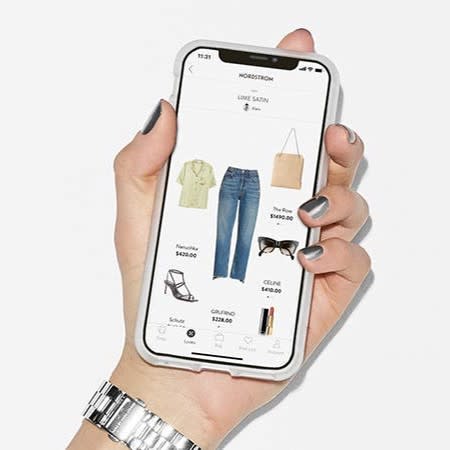Inside Nordstrom 3.0: Discovery, Connection and Personalization
- Oops!Something went wrong.Please try again later.

If there’s one thing that a 120-year-old institution knows, it’s that eventually change always comes for you.
But waiting around for the winds to shift has never been Nordstrom’s thing and, as the retailer marks 12 decades in business, it still isn’t. Today, that perspective informs the company and spurs the velocity of its digital operation.
More from WWD
Why the Fiorucci Store Was the Mother of All Retail Concepts
2020 Holiday Gift Ideas: Google's Top Searched Beauty, Home and Tech Gifts
Unites States Retail in the Aftermath of Police Brutality Protests
Understanding Nordstrom’s vision now and how discovery, convenience and connection pave the way forward demands a look back. Because the pattern was set years ago.
The department store began as a single Seattle shoe purveyor in 1901 and expanded with more product categories, regions and generations of Nordstrom family leadership. Nordstrom Rack, the off-price business launched in 1973, was the first of its ilk among peers such as Neiman Marcus, Saks Fifth Avenue and Bloomingdale’s, which debuted their own respective efforts — the now-defunct Last Call in 1988, Saks Off Fifth in 1990 and The Outlet in 2010.
One particularly illustrative initiative was nordstrom.com’s launch in 1998, a move that turned out to be rather prescient at the time.
Ken Worzel, Nordstrom’s chief operating officer, has been with the company for more than 11 years and sees the through-line from its past to its future, with phases akin to tech-friendly software updates.
“[As] a retailer, we largely sell stuff that people can, if they want to put some effort in, find in other places. So there has to be a reason to have a relationship with us,” he explained. “With JWN 1.0, we delivered that through stores, one customer at a time through a salesperson connecting with the customer in front of them.” JWN is Nordstrom’s listing on the stock market, after founder John W. Nordstrom.
Version 2.0 stemmed from the department store’s investments in a “digital set of touch points with customers,” he said. In-store shoppers had human associates to help with product discovery and evaluation, but there were others who wanted discovery and service without stepping foot in a location.
Nordstrom’s website, along with Nordstrom Rack’s online launch in 2014, begat mobile apps, and thus the contours of the retailer’s digital business started taking shape.
Even in its nascent stages, Worzel said, one of the company’s key principles was that it would not try to dictate where customers shopped. That led to the decision not to break out its merchandising organizations or maintain distinct online product catalogues.

Courtesy photo
Keen-eyed observers may detect the beginnings of what would become “Closer to You,” the strategy unveiled in February 2021. The campaign simultaneously boasts expansion and operational efficiencies across Nordstrom and Nordstrom Rack, along with a slew of digital initiatives, to bring the business closer to customers.
Therein lies Nordstrom, version 3.0.
“The really big opportunity we have now, and the big thing we’re really focused on related to 3.0, is to make digital personal,” Worzel said.
Fundamentally, it’s about connection and bringing the essence of the relationship-based business to the online world. “Historically, that relationship was very much delivered in a one-to-one kind of model, and now we want to be in a one-to-many model,” he continued. “But we also want to make sure that the experience we’re providing for customers at all of our touch points feels like it’s relevant to them, that it’s really designed for them.”
Nordstrom “architected” itself to allow for that, said Worzel. In addition to acquiring technology companies like BevyUp, maker of digital sales tools — primarily style boards — and MessageYes, which developed an artificial intelligence-powered personalized product recommendations engine, it built out a responsive analytics platform capable of churning out deeper insights and predictions.
The system can work for different ends of the business, whether personalized experiences for customers or optimized processes in the back end — from inventory control to fulfillment and order routing. By the company’s count, it leverages more than 100 AI models a day.
Developing a system like this is no easy feat. According to chief technology officer Edmond Mesrobian, the process was three years in the making.
When he joined the company in 2018, he quickly realized he had a lot of work to do.
“When I arrived, I had this perspective of Nordstrom as being digitally advanced. We had our online commerce presence for decades-plus, and it was quite successful,” he recalled. “The words that people were using around the company were ‘data-driven,’ ‘Let’s make a data-driven decision.’
“I was puzzled, because to me, being data-driven is not the same as being a digital enterprise — It’s not connected,” said Mesrobian, a business and tech expert who has held executive roles at Tesco, Expedia and Walt Disney.
Thus began his campaign to break down the department store’s siloed data. Such isolated buckets of information are often a product of corporate thinking that treats online and offline businesses or other departments as separate entities. They’re fine for reporting straight facts, less so for more advanced insights.
“It’s a different thing, when you actually have an enterprise that’s connected, always collecting information, and leveraging AI models to generate predictions and then ‘action’ predictions,” he elaborated. “That is what they weren’t doing.”
They are now.

Courtesy photo
The Nordstrom Analytical Platform treats the business as a single entity, not a collection of disjointed channels. With access to a greater amount and variety of data, NAP can paint a fuller picture of customers — a “customer 360 view,” described Mesrobian — and weigh the store’s bevy of product and inventory information across its own brands and those of partners. The end results are more personalized experiences and more predictive discovery, all in real time.
The major benefit looks like the competitive advantage NAP can bring.
“The battleground today is not about reporting,” the CTO said. Reporting and KPIs, or key performance indicators, were big 10, 15, even 20 years ago. Not today.
Now it’s about one thing: “Being able to leverage predictions for what to do next,” he said. “Can you actually generate predictions and leverage predictions to drive action? Every digital enterprise has to face that battleground.”
At Nordstrom, it extends to both the main business and Nordstrom Rack, which run off the same tech capabilities. That seems more efficient, but it also brings challenges — namely feeling out the nuances of two types of shoppers, “the ‘bargainista’ customer versus the luxury shopper,” Mesrobian said.
“We realize that one platform does not mean one experience. And so what we want to be able to do is leverage one technology platform, one technology organization, but manifest a variety of experiences that are tailored for the context, the situation.”
Not that NAP isn’t already proving valuable. For Nordstrom’s latest annual Anniversary Sale, it created personalized digital catalogues for hundreds of thousands of its best customers. Stories, merchandising and brand teams came together with data and AI to offer a blend of personalized content and product recommendations.

Courtesy image
The sales event also tapped Nordstrom’s so-called “fashion map,” which uses natural language and deep learning so the company can get to know customers better through conversations. The map combined what the store knows about the products and its customers to create messaging that resonated.
“In our email outreach to get them excited about the event, we saw a third-higher engagement rate in terms of opening up those emails, because they were a lot more relevant to the customers,” said Worzel. “And they came back to our site and our app four times more often than other customers.”
That’s not to say that Nordstrom’s trajectory has been a straight line pointing skyward, especially lately. COVID-19’s massive disruption to retail hit department stores particularly hard, and although they’ve been rebounding, there’s still a ways to go.
Indeed, even though Nordstrom’s fiscal second-quarter sales more than doubled from the previous year, thanks in large part to its Anniversary Sale — its revenue haul of $3.66 billion trounced the $1.86 billion revenue figure from a year earlier — the retailer still hasn’t caught up to its pre-pandemic levels, worrying investors.
Perhaps they need perspective. Because the past year and a half was, among many other things, another change for Nordstrom to learn from and manage.
For instance, more than half of its business came from e-commerce last year. That was a first for the department store, and now “we see a path where more than 50 percent of our business is digital, in terms of where the transaction happens,” Worzel offered.
That’s not necessarily the objective, he added. But it’s imaginable now.
Throughout Nordstrom’s evolution, there has been one thing that has always remained the same: Its fixation on the customer.
“For some things, we’ve made sure to stay steadfast and don’t change,” said Worzel. “Our values, that have put us in good stead for 120 years, are keeping the customer at the center of what we do and realizing that retail’s a really tough business, where you have to win that loyalty every day.”
Sign up for WWD's Newsletter. For the latest news, follow us on Twitter, Facebook, and Instagram.

